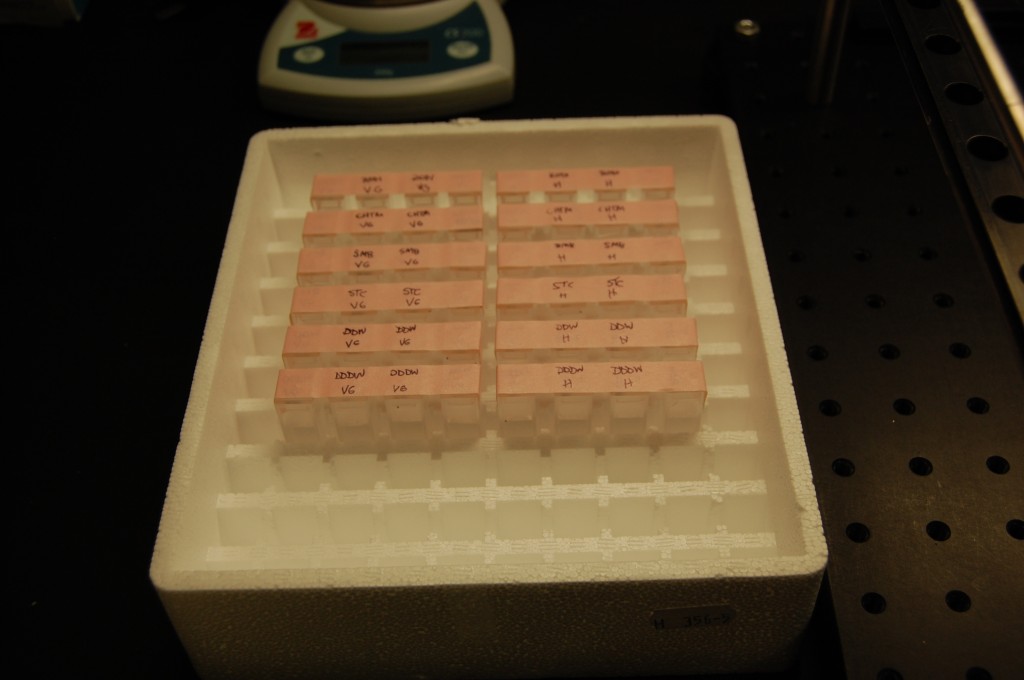I took these pictures on Day 25, but haven’t had time to post them because of all the SDM work. So here they are:
One more set of pictures to take.
I took these pictures on Day 25, but haven’t had time to post them because of all the SDM work. So here they are:
One more set of pictures to take.
A lot of this project is managing how I take pictures of the plants. I’ve talked a lot about my setup and I’ve talked some about how I take pictures and the software I use. Well I’ve had to make some changes to the process and now I’m letting you know so I can continue to be a good open notebook scientist.

Above is a picture of my current setup. I noticed that some seedlings will float in the sample and I couldn’t fit the entire cell in the frame of the camera so I had to find an alternative to my previous method. My solution? Rotate the camera! Simple!
I just found another optical post (4″ in this case) and a 90 degrees post holder. I put the two together and used the post holder from the previous setup (2″ long) to get the current setup. All equipment used in the photo above can be purchased from ThorLabs (and if you buy a bunch you get some lab snacks with your order!).
Also since last time, I added a black backdrop (the one I’m using is a big piece of thick paper). The black provides excellent contrast to the white root hairs.
Finally I’d like to talk about the software that I use. In the previous trial of the DDW experiment (Category: DDW4) I used some software called JPEGCrops to crop the photos in bulk, and I used a program named Rename Master (both open source software) to rename the photos in bulk for organizational purposes.
With this new camera setup, rotating the frame actually allows me to minimize the amount of the other samples in the frame. But I do need to rotate the images in bulk. Windows actually does something right in this regard. If you select a bunch of images and right click, there is an option to rotate the images either clockwise or counter-clockwise in bulk. Using this handy feature saved me a ton of time. Then I can use Rename Master to rename the images in bulk as well.
And that is my whole process, well up until I upload them to my notebook. But from there you can add captions and do some other minor editing features (that I almost never use). Hope this helps someone somehow.
I was supposed to have the day 20 pics today, but I took one picture and the camera battery died so I’ll have to get them up tomorrow. In the meantime I have another day to build a camera holder that can hold the camera vertically so I can fit the entire cell in the frame.

I removed the seeds from the fridge and decided to keep them in a styrofoam cuvette case. This should keep light and temperature pretty stable in the lab. I then put tape over like groups of seeds so I can easily remove the cuvettes and set them up for picture taking.
Believe it or not, that little trick saves me a load of time.
Wow, that sucked. I had to crop, rename, and label 42 pictures for this notebook. Stupid open science movement. Why do I strive to be a good scientist? Why can’t I just let myself be lazy and allow myself to be a bad scientist? Who cares about accurate data and organization?
I do unfortunately.
Anyways here are the Day 0 pictures. Luckily I don’t have to do this every day, that would suck. From now on I may label the water types as follows:
Since the last time I did this, I have learned a ton about proper exposure with a camera. And I actually know what aperture, ISO, and shutter speed are for. I’ll do a post that explains all that but in the mean time here are the settings I used for these pictures and those in the future:
I’m sure these settings are saved with the images so if you download the pics you’ll see the camera settings in photo software.
After 4 trials and talking with Steve, there is no way to ensure that the results we are getting have anything to do with deuterium content. We can’t tell at all that our DI water is just not the same kind of “pure” that the DDW is. So I bought deionized water from Sigma (same people who make our DDW and D2O) to compare with our water and to compare to the DDW results to determine if the root hairs grow based on water purity or if it has something to do with deuterium content.
Here is the setup of the experiment:
Today’s protocol was really easy. I used my macro cuvettes (see Experiment Product Page) and set up 4 cuvettes for each water type giving me a total of 24 cuvettes. I did this so I could set up samples for one seed type at a time, and because I only had enough racks for this many cuvettes. I also prepared the D2O/DDW mixture (29.7mL of DDW, 0.3mL of D2O).
I poured 5-7 seeds in each macro cuvette until all the setup cuvettes had seeds in them. Then I added 3mL of water to the samples (again making 4 samples per water type). Then I sealed the cuvettes with PE caps.
I repeated this setup for the next seed type (24 cuvettes, 5-7 seeds per sample, 4 samples per water type, with 3mL of water per sample) and sealed and labeled all cuvettes.
I placed the cuvettes in the 4C fridge to synchronize the growth among all the samples. Tomorrow I’ll remove the seeds and take Day 1 pictures.